Share this
Types of sinus bone grafting for dental implants in Singapore
on July 3, 2016
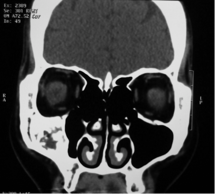 Replacement of missing molars and premolars in the upper jaw with dental implants is often challenging due to a lack of bone. Above the roots of the molars and premolars is the maxillary sinus, which is an empty space within bone that is lined by a layer of tissue which secretes mucous. The mucous helps to humidify the air as it enters through the nose on the way to the lungs. These cells lining also contain hairlike structures that function like a broom, sweeping the mucous and any foreign particles that is trapped in the mucous, out of the sinus and into the nose where they are discharged. There are three other pairs of sinuses in the human skull, serving the same function. In Oriental patients, the maxillary sinus tends to expand quite rapidly with age. In adults, it is not uncommon to have the sinus dipping down between the roots of the molars and premolars.
Replacement of missing molars and premolars in the upper jaw with dental implants is often challenging due to a lack of bone. Above the roots of the molars and premolars is the maxillary sinus, which is an empty space within bone that is lined by a layer of tissue which secretes mucous. The mucous helps to humidify the air as it enters through the nose on the way to the lungs. These cells lining also contain hairlike structures that function like a broom, sweeping the mucous and any foreign particles that is trapped in the mucous, out of the sinus and into the nose where they are discharged. There are three other pairs of sinuses in the human skull, serving the same function. In Oriental patients, the maxillary sinus tends to expand quite rapidly with age. In adults, it is not uncommon to have the sinus dipping down between the roots of the molars and premolars.
When these teeth are lost, be it due to gum disease or tooth decay, the amount of bone left is usually very thin. Furthermore, as the socket heals, more bone is lost. As such, inserting dental implants in the back of the upper jaw is often challenged by the lack of bone. Fortunately, bone can be augmented to support dental implants.
Bone lost due to expansion of the sinus (pneumatization), often results in very thin residual bone. This can be corrected by lifting up the sinus lining and adding bone under the lining to replace the resorbed bone. In general, the sinus lining can be lifted up in two ways.
- Sinus window approach:
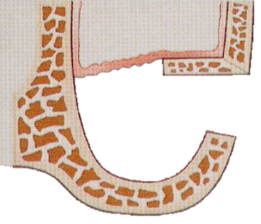
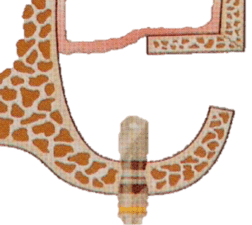
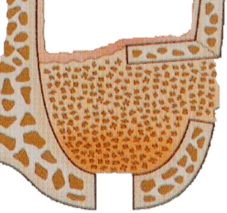
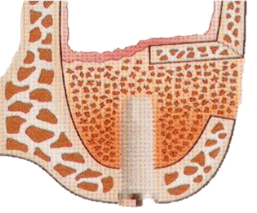
Using this method, the gum overlying the bone is cut and stripped off the bone. The side wall of the sinus bony wall is cut to create a window without cutting into the lining inside. The lining is then slowly teased off the floor of the sinus, creating a space between the lining and the bony floor. A bone graft, which may be bone taken from another part of the patient’s body or synthetic bone material or a mixture, is packed into this space. The window is then covered with a collagen membrane and the gum stitched back over the collagen membrane. After 4-6 months, the bone graft will integrate with the sinus floor and the increased thickness will be able to support an implant. In some cases, if the pre-existing bone is strong enough to support the implant, the implant can be placed at the same time as the bone grafting.
This window approach is usually used when the existing bone in the upper jaw is less than 5-6mm thick. By opening a window, more bone can be grafted.
- Crestal approach:
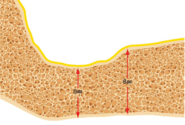
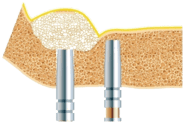
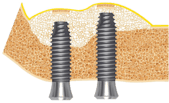
Sometimes, there is only a small shortfall in the bone height required to support and implant and a more minimalist approach to bone grafting can be done without cutting a window into the sinus. For example, if the patient has 8mm of bone and the plan is to place a 10mm long implant, the bone can be placed through the same site as the implant. The implant site is prepared as normal up to a depth of 7mm, just 1mm short of the sinus floor. An osteotome, a blunt instrument, is inserted into the prepared implant site and tapped with a mallet towards the sinus floor. This will cause a slight fracture of the sinus floor at the tip of the implant site without disrupting the overlying sinus lining. The bone graft material is packed into the implant site and pushed up into the sinus while keeping under the sinus lining. Once sufficient bone graft material is packed in, the implant is inserted in the usual way.
There are many variations in the way both approaches are done. Today sinus bone grafting is a very commonly done procedure and has a very high success rate. This is due to the high osteogenic potential of the sinus lining and the protected environment of the sinus that prevents disturbance from eating, speech and any overlying prosthesis.
Share this
- Jaw Surgery (93)
- Dental Implants Singapore (90)
- Orthognathic Surgery (48)
- Replacing Missing Teeth (26)
- Missing Teeth Options (23)
- Underbite (23)
- Bone Grafting (21)
- Costs (18)
- Facial Aesthetics (18)
- Aesthetics (17)
- dental implants (16)
- corrective jaw surgery (15)
- BOTOX (11)
- Dermal Fillers (11)
- Wisdom teeth (10)
- Fixed Implant Dentures (8)
- Loose Dentures Singapore (6)
- Medisave (6)
- sleep apnea (6)
- Braces (5)
- Dental Pain (5)
- Dentures in Singapore (5)
- Loose Teeth (5)
- Tooth Extraction (5)
- jaw deformities (5)
- bimax (4)
- bone graft (4)
- maxillomandibular advancement (4)
- all-on-4 (3)
- bimaxillary protrusion (3)
- chin implant (3)
- facial asymmetry (3)
- full mouth dental implants (3)
- genioplasty (3)
- immediate implant (3)
- removal of an integrated dental implant (3)
- third molars (3)
- wisdom tooth surgery (3)
- My Dentures Don't Fit (2)
- VME (2)
- bone graft healing (2)
- distraction osteogenesis (2)
- medical tourism (2)
- obstructive sleep apnea (2)
- orthodontics (2)
- plastic surgery (2)
- CT guided dental implants (1)
- Double jaw surgery (1)
- Invisalign (1)
- Periodontal Disease (1)
- Permanent Dentures Singapore (1)
- before and after photos (1)
- facial trauma (1)
- fractured dental implant (1)
- oral appliance therapy (1)
- root canal treatment (1)
- veneers (1)
- vertical maxillary excess (1)
- September 2019 (2)
- July 2019 (2)
- May 2019 (2)
- August 2018 (1)
- October 2017 (1)
- September 2017 (2)
- August 2017 (1)
- June 2017 (2)
- May 2017 (4)
- April 2017 (1)
- March 2017 (1)
- February 2017 (3)
- January 2017 (3)
- December 2016 (1)
- November 2016 (2)
- October 2016 (4)
- September 2016 (9)
- August 2016 (5)
- July 2016 (11)
- June 2016 (14)
- May 2016 (6)
- April 2016 (2)
- March 2016 (1)
- January 2016 (7)
- December 2015 (10)
- November 2015 (4)
- October 2015 (9)
- September 2015 (7)
- August 2015 (1)
- July 2015 (6)
- June 2015 (3)
- May 2015 (7)
- April 2015 (5)
- March 2015 (8)
- January 2015 (5)
- December 2014 (7)
- November 2014 (7)
- October 2014 (6)
- September 2014 (8)
- August 2014 (5)
- July 2014 (7)
- June 2014 (8)
- May 2014 (9)
- April 2014 (10)
- March 2014 (6)
- February 2014 (8)
- January 2014 (3)
Subscribe by email
Email subscription




Comments (1)